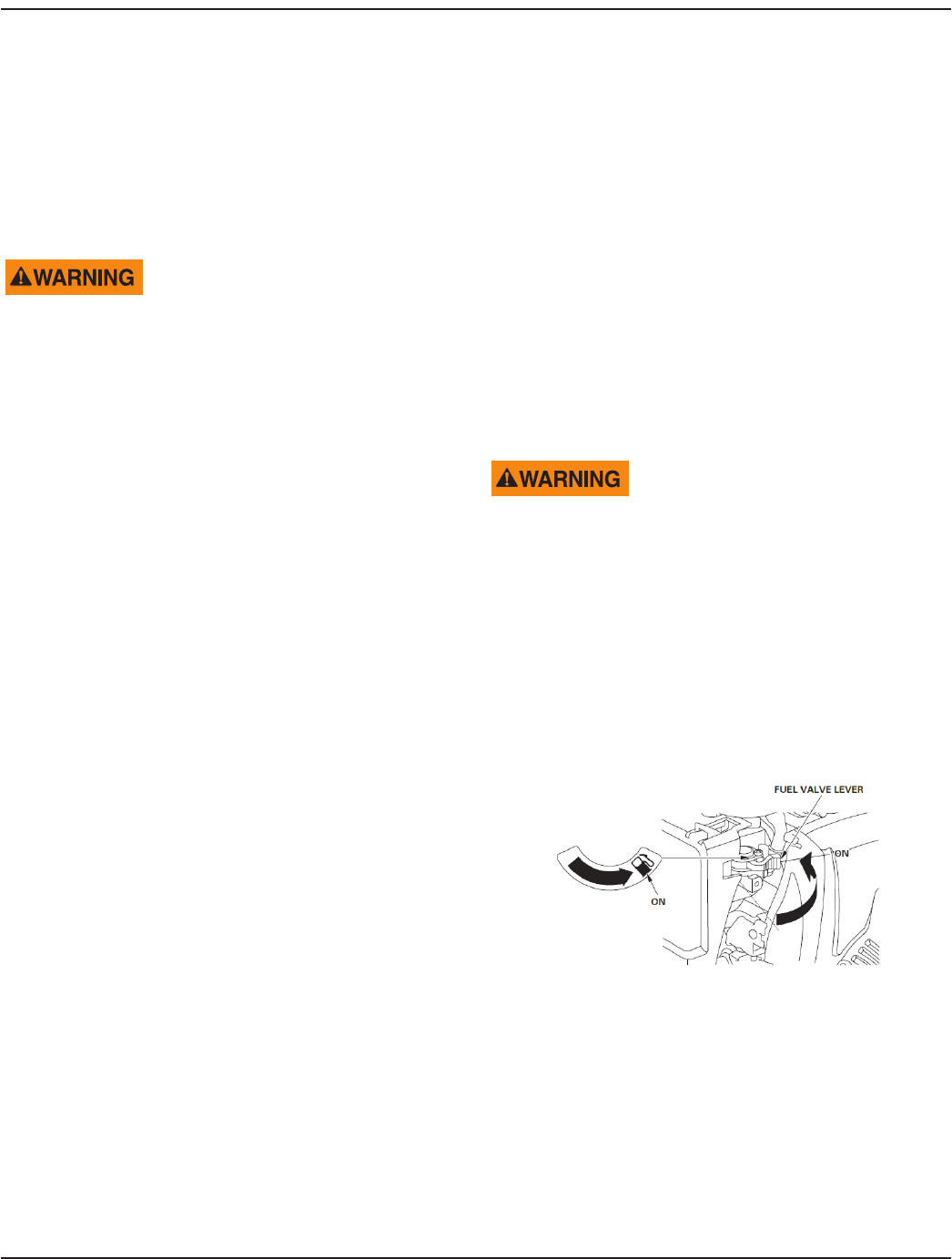Manual
Table Of Contents
- Safety
- Benefits of Vibration
- Head and Shaft Selection
- Adjusting the Backpack
- Pre-Operation Checks
- Operation
- Maintenance
- Servicing the Engine
- Troubleshooting
- Service
- Parts
- Honda Engine Parts
- Honda Engine Warranty
- Wyco Warranty
- Wyco Drawings
- W402535 Backpack Assembly
- W402530 Frame Assembly
- W402600 Speed Increaser Assembly, 1 of 4
- W402600 Speed Increaser Assembly, 2 of 4
- W402600 Speed Increaser Assembly, 3 of 4
- W402600 Speed Increaser Assembly, 4 of 4
- W402316 Replacement Clutch Kit
- W402630 Quick Disconnect Adapter

User Manual
Page 7 March 2014
PREOPERATION CHECKS
Is Your Engine Ready to Go?
For your safety, and to maximize the service life of your
equipment, take a few minutes before you operate the
engine to check its condition. Take care of any problems you
fine, or have your servicing dealer correct them, before you
operate the engine.
IMPROPERLY MAINTAINING THE ENGINE, OR FAILURE
TO CORRECT A PROBLEM BEFORE OPERATION,CAN
CAUSE A MALFUNCTION IN WHICH YOU COULD BE
SERIOUSLY INJURED OR KILLED. ALWAYS PERFORM A PRE-
OPERATION INSPECTION BEFORE EACH OPERATION AND
CORRECT ANY PROBLEM.
Before beginning your pre-operation checks, be sure the
engine is level and the engine switch is in the OFF position.
Always check the following items before you start the engine:
Check the General Condition of the Engine
1. Look around and underneath the engine for signs of oil or
gasoline leaks.
2. Remove any excessive dirt or debris, especially around
the muer and recoil starter.
3. Look for signs of damage.
4. Check that all shields and covers are in place, and all nuts,
bolts and screws are tightened.
Check the Engine
1. Check the fuel level (see “Refueling” on page11).
Starting with a full tank will help to eliminate or reduce
operating interruptions for refueling.
2. Check the engine oil level (see “Engine Oil” on page12).
Running the engine with a low oil level can cause engine
damage.
The Oil Alert system (applicable types) will automatically
stop the engine before the oil level falls below safe limits.
However, to avoid the inconvenience of an unexpected
shutdown, always check the engine oil level before
startup.
3. Check the air filter element (see “Air Cleaner” on
page13). A dirty air filter element will restrict air flow to
the carburetor, reducing engine performance.
4. Check the equipment powered by this engine.
Review the instructions provided with the equipment
powered by this engine for any precautions and procedures
that should be followed before engine startup.
Check the Throttle Lever
The throttle lever controls the speed of the engine. Push it
forward to increase the engine speed. Pull it back to decrease
the engine speed. The lever is an orange hand control
located on the left side of the backpack.
MPORTANTI
The engine will not start if the throttle lever is all the way back
in the OFF position. Push the lever forward about 1/2" into the
SLOW position to engage it.
OPERATION
Safe Operating Precautions
Before operating the engine for the first time, please review
the “Safety” on page5 and “Pre-Operation Checks” on
page7.
CARBON MONOXIDE GAS IS TOXIC. BREATHING IT CAN
CAUSE UNCONSCIOUSNESS AND EVEN DEATH. AVOID
ANY AREAS OR ACTIONS THAT EXPOSE YOU TO CARBON
MONOXIDE.
Vibrator Heads rotate at twice the speed of the engine and
are designed for nominal speeds of 12,000…13,000 RPM
(Engine speed of 6,000…6,500 RPM). Operating at excessive
speeds may reduce the performance or life of the product.
Starting the Engine
Move the fuel valve to the ON position.










